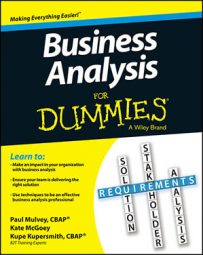Definition tools help you define requirements in your business analysis as productively and effectively as possible. Some requirements are best defined by using only text, while other requirements are better served by graphical or visual definition. Definition tools support one or both of these styles.
Textual definition tools
If you need to define things like glossary definitions, project descriptions and objectives, and stakeholder analysis information, use a textual definition tool. Usually, business analysts use word processing applications or spreadsheet programs to compile this information into paragraphs and tables; however, the information often turns into extraordinarily long documents.
If you’d rather go for brevity, opt for index cards, markers, and sticky notes, which keep the bits of information manageable. Agile teams frequently use this approach to define user stories that capture the essence and goal of the requirements without getting too bogged down in tool or process overkill.
They capture details about requirements on the index cards and then sort and organize the cards across conference room tables or tape them up on walls. (In this context, agile refers to a group of software development methods where requirements and solutions are developed through collaboration.)
Quite a few electronic tools provide features and functions to define stories that mimic the look and function of the index cards! If you like that angle, look for tools with features that organize and define the requirements, acceptance criteria, and resulting project tasks in usable views and prioritized order.
Modeling and diagramming tools for business analysis
When you need visuals, use modeling and diagramming tools. Models and diagrams frequently seen in business analysis efforts include the following:
Business process flows and logical models of all flavors, such as
Swimlane diagrams
Decision models or diagrams
Data models (entity relationship diagrams)
Organizational or operational models
Scope diagrams, such as a context data flow diagram
System context or architecture diagrams
Use case diagrams
Process decomposition diagrams
You can create these items by using low-tech paper and pencil or markers on a flip chart, which is very efficient. However, that result may not be particularly neat, formally presentable, or appropriate for your audience. In that case, some mid-tech tools speed your ability to create and update diagrams yourself with a computer; they feature buttons and menus for drawing standard shapes or creating clean lines.
Some tools allow you to record meta data (data about data) with fields that define information about the boxes, lines, or information you’ve drawn on the diagram. Collaboration with mid-tech tools is manual, where one person drives the tool while others watch or contribute suggestions for the driver to address and incorporate.
Opt for high-tech tools if you need to take it further. They have features for defining, modeling, elaborating, reviewing, simulating, and collaborating — all within a single tool or suite of tools. These modeling and diagramming tools provide features fused with other options that support definition by
Creating diagrams for you: They generate items such as process flow diagrams based on a word, language, or grammar analysis of your textual requirements.
Providing templates and techniques: They allow you to enter information in one manner while the tool translates the information for display in another manner.
Offering workflow or notifications about requirements: Team members concerned with certain requirements get updates or changes the instant those items are documented but not any they don’t care about.
Designing process code or generating development code based on the process models or design diagrams you create: This feature increases team efficiency.
Creating or providing a central storage place where requirements can be more easily shared or reused across projects.
Linking together and tracing all different kinds of requirements from and to one another: You can track requirements from original need to implementation/destination. Advanced features offering traceability ensure more complete requirements definition and enable you to perform gap and impact analyses around the solution, especially valuable on very large projects.
Prototyping and simulation tools for business analysis
Prototyping is a type of definition and modeling tool, but rather than modeling process and manual workflow, you’re modeling screens and application work flow. Prototyping tools enable analysts and designers to imagine and illustrate what the software screens and applications will look like before they’re built, by leveraging drawings and wireframing (mockup) capabilities.
When designed, users and stakeholders can review those prototypes and provide feedback early in the lifecycle rather than toward the end.
Prototype tools can range from the very low-tech (paper, marker, whiteboard), to mid-tech (simple electronic drawing tools without many bells and whistles) to very high-tech and advanced (tools built for designers and artists whose focus is creating high-fidelity graphic designs).
Simulation tools (sometimes called or created from pseudo-code) are one variety of high-tech prototyping tool. Their features take prototypes a few steps further by activating them for stakeholders to try out; however, the screens don’t actually work. A simulation isn’t working software; it’s an active picture or application example that demonstrates how the functionality of software will work after it’s built in the future.
These tools add value by supporting the fact that sometimes seeing is believing. If stakeholders can get a look at what’s going to be built, they can provide feedback about what they’d change before changing it is too expensive.
For that reason, many definition tool vendors are incorporating prototyping and simulation features into their tool suites for full coverage. The more easily you can go from creation of requirements through visualization of the solution, the faster and cheaper the development effort!

